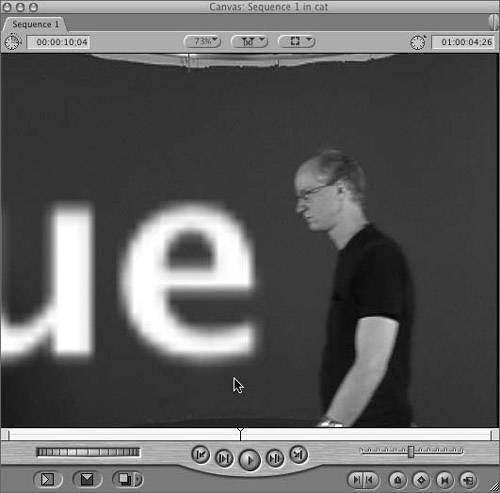Image Sizing and Scaling Issues
Symptom #1: Fuzzy and Pixelated Images"When I scale a still image above 100% in the Motion tab, it becomes pixelated or fuzzy." BackgroundIn print media, you can vary the resolution of an image (measured in dots per inch, or dpi) to get more or less sharpness. A video frame on the other hand has no variation in resolution. No matter how big your video monitor is, its native resolution is 72 dpi. When you bring a 72 dpi image into FCP, it has a "one to one" relationship with what you will see on the resulting video output to the deck. It will appear at its highest, non-interpolated quality when it is scaled to 100% in the Motion tab. This is why we say it is native at 72 dpi. Note The only exception to this maxim is the PC platform's use of 96 dpi for PC computer monitor resolution. Mac's have always matched the standard 72 dpi resolution of broadcast video. This should only concern you if you are generating video destined for the Web that needs to look identical on both PCs and Macs. You can use higher resolution images in FCP HD, which supports nearly unlimited pixel frame sizes. Using higher resolutions in graphics lets you keyframe Ken Burnsstyle pan-and-scan animations and gives you more flexibility when tweaking the size of the image for better screen composition. Scaling images above 100% in the Motion tab of the Viewer may result in pixelationa form of artifacting that appears as fuzzy or blocky loss of detailwhich is the result of FCP trying to make up pixels that did not exist in the original. SolutionAlthough small adjustments may not result in noticeable quality loss, you should use a dedicated graphics application to resize your graphics.  Symptom #2: Project Opens Slowly and Is Unresponsive"My project containing a lot of high-resolution scanned images takes 10 or more minutes to open." BackgroundThere is a drawback to using high-resolution images in a FCP project; the higher the resolution in the image, the more processing required to make it available to the project. This can result in very slow project launches and frequent "preparing video for display" delay alerts. SolutionIn general, restrict the resolution of your images to the maximum that is useful to avoid performance hits. If you need to use a resolution higher than 72 dpi, one tool you may find useful is Scan Guide Junior, which is included in the Extras folder on this book's DVD. The tool performs a simple calculation to help you determine the correct dpi for an image. For example, an 8" x 10" image at 72 dpi will look pixelated when doubled in size. However, if the original image had a resolution of 144 dpi, doubling the size of the image would result in no discernable loss of quality. |
EAN: N/A
Pages: 205